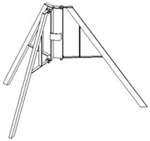Aug . 16, 2024 16:36 Back to list
Falsework System Solutions Provider for Construction Industry Efficiency and Safety
The Role of Falsework Systems in Construction A Spotlight on Manufacturers
In the dynamic world of construction, the successful execution of projects often hinges on effective support systems designed to bear weight before permanent structures are completed. Among these systems, falsework plays a crucial role. Typically defined as a temporary structure used to support a vertical or horizontal element while it is being constructed, falsework systems are essential in ensuring the safety and stability of construction operations. The demand for high-quality falsework systems has led to the emergence of specialized manufacturers whose expertise shapes the industry.
Understanding Falsework Systems
Falsework systems encompass a variety of components, including beams, columns, and props that form the framework for temporary structures. These systems provide crucial support for various construction activities, such as pouring concrete for bridges, high-rise buildings, and other infrastructural projects. Properly designed and implemented falsework is vital to meet load requirements, ensure worker safety, and maintain project timelines.
Moreover, falsework acts as a temporary scaffold that allows construction teams to work efficiently at heights and across varying terrains. With advancements in construction technology and materials, modern falsework systems are engineered for increased strength, flexibility, and ease of assembly, making them invaluable on any job site.
The Importance of Manufacturers
The role of falsework system manufacturers cannot be overstated. These companies specialize in the design, production, and supply of falsework components tailored to the unique needs of each project. Manufacturers must keep pace with the evolving standards and regulations in the construction industry. This ensures that their products meet safety standards while also offering innovative solutions that enhance productivity.
Leading manufacturers invest heavily in research and development, focusing on materials that offer superior strength-to-weight ratios and durability. The shift towards modular systems, which allow for easier assembly and disassembly, has transformed how falsework is employed in projects. This innovation not only reduces labor costs but also minimizes the time required for setup and teardown, further contributing to the efficiency of construction operations.
falsework system manufacturer

Customization and Client Collaboration
One of the key aspects of a successful falsework system manufacturer is the ability to provide customized solutions
. Every construction project comes with its unique challenges, and a one-size-fits-all approach often falls short. Experienced manufacturers work closely with architects, engineers, and project managers to develop tailored falsework systems that meet specific project requirements.Collaborative efforts involve comprehensive planning, where manufacturers analyze load demands, site conditions, and safety regulations to create efficient falsework designs. This level of customization ensures that the systems utilized are not only compliant but also optimized for performance, thereby enhancing the overall success of a construction project.
Future Trends in Falsework Systems
As the construction industry continues to evolve, so too will the demands placed on falsework system manufacturers. Sustainability is becoming an increasingly vital consideration. The move towards eco-friendly construction practices means manufacturers are exploring materials that are recyclable or have a lower environmental impact.
Additionally, the integration of technology, such as digital modeling and real-time monitoring, will shape the future of falsework systems. These tools allow for better planning and safety assessments, minimizing risks on-site.
Conclusion
The role of falsework system manufacturers in the construction industry is pivotal. Their expertise not only facilitates the safe and efficient completion of projects but also contributes to the advancement of construction methodologies. As manufacturers continue to innovate and adapt to industry needs, they play a fundamental role in shaping the landscape of modern construction, ensuring that structures are built safely, sustainably, and effectively.
-
High-Quality U Head Jack Scaffolding – Reliable Scaffolding Jack Head Manufacturer & Factory
NewsJul.08,2025
-
High-Quality I Beam H20 Leading Timber Beam H20 Material Factory, Exporters & Manufacturers
NewsJul.08,2025
-
High-Quality Powder Coating Steel Formwork - Durable & Corrosion Resistant Solutions
NewsJul.07,2025
-
Inclined Column Formwork Supplier – Durable & Precise Solutions for Unique Structures
NewsJul.07,2025
-
High-Quality Water Stop Solutions Trusted Water Stop Company & Suppliers
NewsJul.07,2025
-
High-Quality Formwork Material Supplier Reliable Manufacturer & Factory Solutions
NewsJul.06,2025